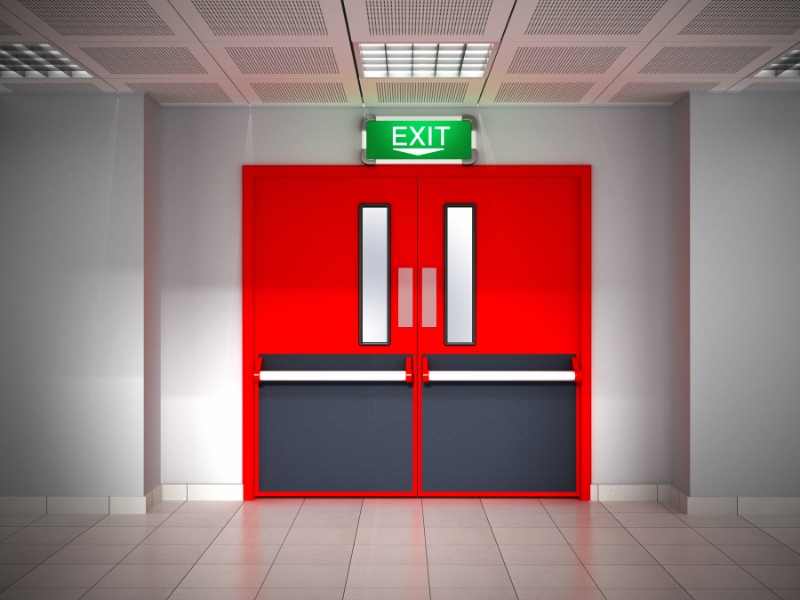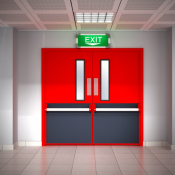
What is a Fire Door Inspection?
When it comes to fire safety in the workplace, few elements are as vital as the humble fire door. These specialist doors are your first line of defence—slowing the spread of fire and smoke, providing essential time for evacuation, and protecting lives and property. But they’re only effective if properly maintained. That’s where fire door inspections come in.
If you’re a business owner, property manager, or responsible person under the Regulatory Reform (Fire Safety) Order 2005, you have a legal duty to ensure your fire doors are regularly inspected and fit for purpose. So what does a fire door inspection actually involve—and why is it so important?
Why Fire Doors Matter
Fire doors are specially constructed to resist fire and smoke for a specified amount of time—usually 30 or 60 minutes (FD30 / FD60). They:
- Help compartmentalise buildings during a fire
- Prevent fire and smoke from spreading rapidly
- Protect escape routes
- Reduce property damage
- Save lives
But like any safety system, fire doors only work if they’re maintained correctly. A fire door that doesn’t close properly, has damaged seals, or lacks correct signage could fail in an emergency.
Relevant Guidance and Legislation on Fire Door Inspections
The importance of fire door inspections has grown significantly in the last decade — particularly after high-profile tragedies such as the Grenfell Tower fire in 2017, where systemic failures in fire safety contributed to the loss of 72 lives. While Grenfell did not involve specific failures of fire doors as the primary cause, it highlighted the critical role passive fire protection plays in containing fire and smoke. Fire doors have since come under increased scrutiny, and rightly so.
There are now multiple pieces of legislation, regulations, and standards that reference fire door inspections. However, the guidance varies depending on the type of building and industry, creating a complex and sometimes inconsistent picture. Here’s what you need to know:
The Regulatory Reform (Fire Safety) Order 2005
Under the Fire Safety Order, the responsible person (usually the employer, building owner, or occupier) must take general fire precautions to ensure the safety of employees and others. This includes maintaining fire safety equipment and critical elements of fire protection systems, such as fire doors.
- While the Order does not specify exact inspection frequencies, it places a legal duty on the responsible person to ensure fire doors are maintained in good working order.
- Article 17 is the key clause here — it explicitly states that fire safety equipment must be maintained in an efficient state, in efficient working order and in good repair.
Fire Safety (England) Regulations 2022
Introduced as part of the post-Grenfell regulatory response, these regulations apply specifically to multi-occupied residential buildings in England.
They state that:
- Flat entrance doors must be inspected at least annually.
- Fire doors in communal areas must be checked quarterly.
- Residents must be informed about fire door safety and maintenance.
These new rules formalise a minimum inspection standard in residential contexts — something that has been long overdue.
BS 8214 – Timber-Based Fire Door Assemblies
BS 8214:2016 is the British Standard for timber-based fire door sets. It sets out best practice for installation, inspection, and maintenance and notes:
- Fire doors must be installed and maintained in accordance with manufacturer’s instructions.
- The standard refers to third-party certification schemes, such as those provided by the British Woodworking Federation (BWF Certifire), which provide additional assurance of quality and traceability.
- The inspection checklist includes gaps, intumescent strips, signage, hinges, self-closing devices, and more.
BS 9999 – Code of Practice for Fire Safety in Design and Management
BS 9999 recommends that:
- Fire doors should be inspected at six-month intervals.
- Inspection should include operation of the door, condition of the frame, seals, and hardware.
This standard is widely referenced in commercial buildings and aligns with many industry best practices.
SFG20 – Planned Maintenance Specification
SFG20 is a facilities maintenance standard that is commonly used in building management software and maintenance contracts. It typically adopts the BS 9999 six-month inspection interval for fire doors, though this can be customised based on risk.
HTM 05-02 – Health Technical Memorandum (NHS Estates)
Healthcare settings fall under HTM guidance, which outlines more granular, risk-based approaches:
- Fire doors in critical areas may require daily or weekly checks.
- Inspection frequency is based on occupancy type, dependency levels, and frequency of use.
Supporting bodies such as IHEEM (Institute of Healthcare Engineering and Estate Management) often issue practical guidance for applying these standards in real-world healthcare environments.
The Real-World Challenge
As you can see, guidance and expectations vary significantly across sectors and building types. There is no single universal standard for fire door inspection frequency, which can lead to confusion, inconsistency, and even neglect.
To make matters worse:
- Procurement practices often lead to all doors in a building being of similar specification, regardless of their intended function.
- Not all fire exits are fire doors, and not all fire doors are fire exits.
- Some fire doors are in low-use areas, meaning damage can go unnoticed for months.
- Inadequate training among facilities teams can result in inspections being carried out by unqualified personnel.
This landscape of inconsistent standards, variable risk, and ambiguous duties makes one thing abundantly clear: fire door inspections must be approached with diligence, clarity, and professional expertise.
What Does a Fire Door Inspection Include?
A fire door inspection is a detailed check by a competent person to ensure that the door, its frame, and all associated components meet legal standards and manufacturer specifications. Key elements of a fire door inspection include:
1. Door Leaf Integrity
Inspectors check for any visible damage—cracks, warping, holes, or delamination—that may compromise the door’s performance in a fire.
2. Intumescent and Smoke Seals
These heat-activated seals expand during a fire to close gaps around the door. They must be correctly fitted, continuous, and undamaged.
3. Hinges and Hardware
Fire doors typically require a minimum of three hinges. Inspectors check for missing screws, signs of wear, or corrosion. All hardware should be CE-marked and appropriate for fire doors.
4. Self-Closing Devices
The door must close fully and latch under its own power. This is a legal requirement—wedging open a fire door, or having one that doesn’t shut properly, is a serious safety risk.
5. Clearances and Gaps
Gaps around the top and sides of the door should generally be no more than 3–4mm. However, the threshold (bottom) gap varies:
- For standard fire doors, up to 8mm is typically acceptable.
- For doors on escape routes, the maximum allowed is 3mm ±1mm in accordance with BS 8214.
Even small deviations can allow fire and smoke to bypass the door, undermining its performance.
6. Door Signage
Legally required signs—such as “Fire Door – Keep Shut” or “Fire Door – Keep Locked”—must be present and clearly visible on both sides of the door.
7. Glazing and Vision Panels
If present, any glass used in a fire door must be fire-resistant and properly glazed. Beading should be secure and undamaged.
8. Locks, Latches, and Panic Furniture
Any locking devices must be compatible with fire doors and must not prevent the door from closing or latching properly.
Repairs and Adjustments: What’s Allowed?
Repairing fire doors is a frequent point of confusion and industry debate. While some remedial works are considered acceptable, there is limited official guidance and much depends on the competency of the person doing the work and whether the door remains compliant with its original certification.
Common areas of uncertainty include:
- Can you adjust or pack hinges using intumescent packers?
- Can you add hardwood lippings or edge seals to reduce gaps?
- Are repairs to damaged cores or facings ever acceptable?
In general:
- Minor adjustments (e.g. tightening hinges, lubricating closers) are usually fine.
- Packing or shimming hinges to correct alignment can be acceptable if done with intumescent materials and doesn’t affect certification.
- Adding material to door edges can invalidate certification unless approved by the manufacturer or supported by certified repair schemes.
For this reason, many fire door professionals recommend consulting the original manufacturer or using third-party approved repair methods through schemes like BWF-Certifire.
Who Can Undertake a Fire Door Inspection?
There’s ongoing debate around who is qualified to carry out a fire door inspection. Some argue that only individuals certified by BM TRADA (Q-Mark) or the FDIS (Fire Door Inspection Scheme) should perform inspections, as they assess doors to manufacturer tolerances and certification standards.
However, the Fire Safety (England) Regulations 2022 take a more flexible view:
“It is not a requirement for inspections to be carried out by specialists. They can be carried out by those with appropriate training or knowledge. This may include appropriately trained in-house staff.”
This matters.
- BM TRADA and FDIS inspectors assess against manufacturer standards, which may lead to over-specification of remedial work.
- The FSR approach is more functional and practical, requiring that the person inspecting is competent and understands what to look for — not necessarily formally certified.
In short, competency is key — whether that comes from third-party certification or structured in-house training depends on the risk profile and context of your building.
Why Are Regular Fire Door Inspections So Important?
Fire doors can deteriorate over time due to wear and tear, misuse, or environmental factors. Even minor defects—like worn seals or loose hinges—can seriously affect performance.
Regular inspections help you:
- Meet legal obligations
- Maintain insurance validity
- Reduce risk of enforcement action
- Protect lives in an emergency
Under UK fire safety law, fire doors should be checked at least every six months, or more frequently in high-traffic or high-risk environments.
What Happens After a Fire Door Inspection?
After the inspection, you should receive a detailed report outlining:
- The condition of each fire door
- Any defects or non-compliance issues
- Recommended remedial actions
It’s essential to carry out these repairs promptly. Delaying could leave your building non-compliant and at risk.
Summary
- Fire doors are critical safety assets, designed to slow the spread of fire and smoke.
- A proper inspection checks integrity, seals, hinges, closers, signage, and more.
- Guidance varies: some settings require checks every quarter, others may need daily reviews.
- Legal standards are evolving — and there’s often debate over who can inspect and how far repairs can go.
- Ultimately, inspections must be competently performed and lead to clear action.
Find a Verified Fire Safety Consultant
If you’re unsure whether your fire doors are compliant, don’t guess — speak to a verified expert.
At MySafetyConsultant.io, we connect you with experienced fire safety consultants who can carry out detailed inspections and help you understand your legal duties.
- Thorough inspections
- Clear reporting
- Practical advice
- Nationwide coverage
Find a verified fire safety consultant today



